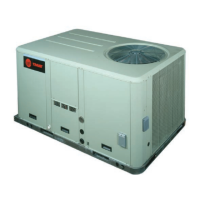Troubleshooting
74 RT-SVX21AC-EN
Zone Sensor LED 3 (Cool)
“On” when the cooling cycle is operating.
“Off” when the cooling cycle terminates or the LED fails.
“Flashing” indicates a cooling failure.
Zone Sensor LED 4 (Service)
“On” indicates a clogged filter.
“Off” during normal operation.
“Flashing” indicates an evaporator fan or condensate
o
verflow sw
itch failure.
Below is the complete listing of failure indication causes.
System failure
Check the voltage between terminals 6 and 9 on J6, it
should read approximately 32 Vdc. If no voltage is present,
a system failure has occurred. Refer to Step 4 in the
previous section for the recommended troubleshooting
procedure.
Heating Failure
Verify Heat Failure by Ignition Module (IGN) LED indicator:
OFF: No Power or Failure
ON: Normal
Slo
w Flash: N
ormal
, Heat Call
Fast Flash: Error Code:
1 Flash:
Communication Failure
2 Flashes: System Lockout
3 Flashes: Pressure Switch Fail
4 Flashes: TC01
o
r TC02 Open
5 Flashes: Flame w/o Gas Va
lve
6 Flashes: Flame Ro
llout Open
Cooling Failure
• Cooling and heating set point (slide pot) on the zone
sensor has failed. Refer to the “Zone Sensor Test
Procedure” section.
• Zone temperature thermistor ZTEMP on ZTS failed.
Re
fer to the
“Zone Sensor Test Procedure” section.
• CC1 or CC2 24 Vac control circuit has
opened, check
CC1 and CC2 coils, and any of the controls below that
apply to the unit (HPC1, HPC2).
• LPC1 has opened during the 3 minute minimum “on
tim
e” during
4 consecutive compressor starts, check
LPC1 or LPC2 by testing voltage between the J1-1 and
J3-2 terminals on the RTRM and ground. If 24 Vac is
present, the LPC’s has not tripped. If no voltage is
present, LPC’s has tripped.
Service Failure
• If the supply fan proving switch has closed, the unit will
not operate (when connected to RTOM), check the fan
motor, belts, and proving switch.
• Clogged filter switch has closed, check the filters.
• If the condensate overflow switch is closed, the unit
will not operate. Make
sure the float switch is not in a
tripped condition, and check for an “open” between
wires connecting to RTOM J6-1, J6-2 (ReliaTel™
controls).
Simultaneous Heat and Cool Failure
• Emergency Stop is activated
Method 2
The second method for determining system status is done
by checking voltage readings at the RTRM (J6). The
system indication descriptions and the approximate
voltages are listed below.
System Failure
• Measure the voltage between terminals J6-9 and J6-6.
• Normal Operation = approximately 32 Vdc
• System Failure = less than 1 Vdc, approximately 0.75
Vdc
• Test Mode = voltage alternates between 32 Vdc and
0.
75 Vdc
Heat Failure
• Measure the voltage between terminals J6-7 and J6-6.
• Heat Operating = approximately 32 Vdc
• Heat Off = less than 1 Vdc, approximately 0.75 Vdc
• Heating Failure = voltage alternates between 32 Vdc
an
d 0.75 Vdc
Cool Failure
• Measure the voltage between terminals J6-8 and J6-6.
• Cool Operating = approximately 32 Vdc
• Cool Off = less than 1 Vdc, approximately 0.75 Vdc
• Cooling Failure = voltage alternates between 32 Vdc
an
d 0.75 Vdc
Service Failure
• Measure the voltage between terminals J6-10 and J6-
6.
• Clogged Filter = Approximately 32 Vdc.
• Normal = Less than 1 Vdc, approximately 0.75 Vdc Fan
F
ailure = voltage alternates between 32 Vdc and 0.75
Vdc.
To use LED’s for quick status information at the unit,
purc
hase a BAYSENS110* ZSM and connect wires with
alligator clamps to terminals 6 through 10. Connected
each respective terminal wire (6 through 10) from the Zone
Sensor to the unit J6 terminals 6 through 10.
Note: If
the system is equipped with a programmable
zone sensor, BAYSENS119* the LED indicators will
not function while the BAYSENS110* is connected.

